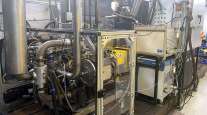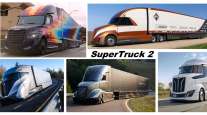Senior Reporter
Age of Electric Box Trucks Within Reach, NACFE Reports

[Stay on top of transportation news: Get TTNews in your inbox.]
The entire U.S. and Canadian market of hundreds of thousands of simple medium-duty box trucks will come to embrace electrification, leading the way for other more complex medium-duty applications over the next decade as the industry pursues zero emissions, according to the North American Council for Freight Efficiency.
“Tackling relatively simple and straightforward applications such as box trucks provides the trucking industry with a launching point to design, build, validate and refine battery-electric trucks,” NACFE wrote in its report, Electric Trucks Have Arrived: The Use Case For Medium-Duty Box Trucks.
Box trucks that run a daily route then return home are the ideal candidates for electrification — as are applications where electrification can power aspects of the truck body. Other vehicles that can stay out longer, like snowplows, and fire and utility trucks, present a greater challenge for electric powertrains, according to NACFE, which added some electrified prototypes of them will emerge, but likely in limited volumes in the near future.
MD Box Trucks Report FINAL by Transport Topics
Truck equipment manufacturers, also known as body builders, will respond with a wide variety of bodies for medium-duty chassis. “While a simple van body doesn’t require a lot of additional engineering or validation, many other applications will be much more challenging in terms of installation, operations, safeguards and more,” NACFE wrote in the report.
Achieving such a shift to electrification with the simpler box truck segment — about 380,000 trucks in the United States and Canada — would result in the avoidance of 7.7 million metric tonnes of CO2e (carbon dioxide equivalent, including a bundle of multiple greenhouse gases) annually, NACFE reported.
Medium-Duty Box Trucks Ideal for Electrification – More complex medium-duty applications will face a longer road to electrification. https://t.co/dyWrtsSdtN pic.twitter.com/ud9EQmNgjq — North American Council for Freight Efficiency (@NACFE_Freight) June 28, 2022
The Run on Less – Electric demonstration completed in September lasted three weeks and this final report focused on the medium-duty box truck segment of the trucking industry.
Terminal tractors, vans and step vans and heavy-duty regional haul tractors generated their own reports earlier.
The three fleet-OEM pairs in the medium-duty box truck market segment were:
- Day & Ross with a Class 6 Lion6
- Frito-Lay with a Class 6 Peterbilt-Cummins 220EV
- Roush Fenway Racing with a Class 6 Roush CleanTech Ford F-650
All three vehicles were instrumented with a Geotab telematics device that tracked daily range, speed profiles, state of charge, charging events, amount of regenerative braking energy recovery, weather and number of deliveries, NACFE noted.
Want more news? Listen to today's daily briefing above or go here for more info
“This report’s conclusions were generated through the data collection and calculations from the three medium-duty box trucks that participated in Run on Less – Electric, interviews conducted with representatives from the participating fleets and tractor builders and input from other industry experts.”
Among the lessons learned:
- In order to be valuable for medium-duty box trucks, public charging stations need to be bigger.
- Predicting battery life is difficult with significant body loads.
- Charging ports on the trucks should be standardized.
The report concluded, “Finding grants and incentives to make the vehicles more affordable is not easy and available funds disappear quickly when they become available. Charging infrastructure presents an entirely new set of challenges for fleets from parking lot planning, to building permits, inspection approvals and operations. What has been very positive is the response of the drivers that have driven these electric trucks.”




